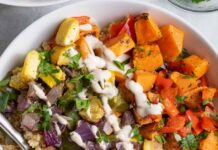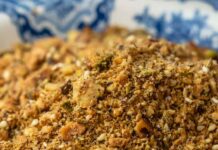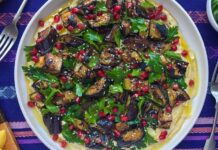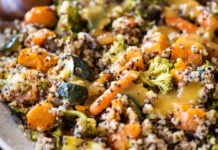There’s something undeniably magical about transforming humble vegetables into show-stopping dishes with nothing more than heat, spice, and a little culinary inspiration.
Roasted cauliflower, in particular, has earned a permanent place in my kitchen rotation—not just for its versatility, but for its remarkable ability to absorb bold, complex flavors.
Today, we’re giving this beloved vegetable a fiery, aromatic twist inspired by the vibrant cuisines of Lebanon, using RoboFood Batata Harra Seasoning and a rich drizzle of pomegranate molasses.
The result?
A smoky, spicy, sweet, and tangy roasted cauliflower dish that’s as stunning on your dinner table as it is satisfying on your palate.
Why This Recipe Works
This dish takes the traditionally simple preparation of roasted cauliflower and elevates it with a deeply flavorful spice profile.
The RoboFood Batata Harra Seasoning—a blend of chili, garlic, coriander, and paprika—brings a robust heat and earthy warmth that penetrates every crevice of the cauliflower florets.
When roasted at high heat, these spices bloom, intensifying their aroma and creating a subtle char that adds smokiness.
But what truly sets this recipe apart is the final flourish: pomegranate molasses.
This syrupy, tart-sweet reduction balances the heat with a fruity tang, echoing traditional Levantine flavor pairings and lending a glossy sheen that makes every bite irresistible.
The Star Ingredients
Let’s take a closer look at the two powerhouse elements that make this recipe shine:
RoboFood Batata Harra Seasoning
Designed to replicate the beloved Lebanese batata harra—a spicy garlicky potato dish—this seasoning blend is anything but one-note.
Its foundation of dried red chili flakes brings immediate heat, while roasted garlic powder adds depth.
Ground coriander contributes a citrusy, slightly floral note, and smoked paprika (or sweet, depending on the variant) adds warmth and a hint of smokiness.
Together, these ingredients create a layered spice mix that’s not just hot, but aromatic and deeply savory.
What makes this seasoning ideal for cauliflower is its ability to cling well to the vegetable’s surface.
Unlike wet marinades that can steam instead of crisp, a dry spice blend like this encourages caramelization and browning—key for texture development.
Pomegranate Molasses
A staple in Middle Eastern pantries, pomegranate molasses is a concentrated reduction of pomegranate juice, sugar, and lemon juice.
It’s tart, slightly sweet, and packed with fruity complexity.
In this recipe, it’s used sparingly as a finishing sauce—just enough to cut through the heat and elevate the dish with jewel-like acidity.
A drizzle just before serving enhances both flavor and presentation, especially when sprinkled with fresh pomegranate seeds.
How to Make Spicy Roasted Cauliflower with Batata Harra
This recipe is straightforward, but a few key techniques ensure the best results.
Ingredients
- 1 large head of cauliflower, cut into even florets
- 3 tablespoons olive oil (extra virgin preferred)
- 2 tablespoons RoboFood Batata Harra Seasoning
- 1 teaspoon sea salt (optional, depending on seasoning blend sodium)
- ½ teaspoon freshly cracked black pepper
- 2 tablespoons pomegranate molasses
- Fresh parsley or cilantro, chopped (for garnish)
- ⅓ cup pomegranate seeds (optional, for crunch and color)
- Toasted pine nuts or slivered almonds (optional garnish)
Step-by-Step Instructions
- Preheat the oven to 425°F (220°C). High heat is essential for achieving crispy edges and tender centers. Line a large baking sheet with parchment paper or lightly grease it to prevent sticking.
- Prepare the cauliflower. Rinse the florets and pat them completely dry. Moisture is the enemy of crispiness, so take care to dry them thoroughly. Place them in a large mixing bowl.
- Mix the spice coating. In a small bowl, combine the olive oil, RoboFood Batata Harra Seasoning, salt (if using), and black pepper. Whisk to form a paste-like consistency. The oil helps the spices adhere and promotes even browning.
- Coat the cauliflower. Pour the spice-oil mixture over the florets. Use your hands or a spoon to toss until every piece is evenly coated. Let it sit for 5–10 minutes to allow the spices to penetrate slightly.
- Arrange on the baking sheet. Spread the florets in a single layer, ensuring they’re not crowded. Overlapping pieces will steam instead of roast, compromising texture.
- Roast for 20 minutes. After 20 minutes, flip each piece using tongs or a spatula. This ensures even browning on all sides.
- Continue roasting for another 15–20 minutes, or until the cauliflower is deeply golden, slightly charred at the edges, and tender when pierced with a fork.
- Finish with pomegranate molasses. Remove from the oven and immediately drizzle the molasses over the hot cauliflower. The heat helps distribute the syrup and intensify its flavor.
- Garnish and serve. Sprinkle with fresh herbs, pomegranate seeds, and toasted nuts for contrast in texture and color. Serve warm.
Why High Heat Matters
The key to great roasted cauliflower is temperature control.
Lower heats can result in a soggy or mushy texture, while high heat encourages Maillard browning—those delicious caramelized edges that make roasted vegetables irresistible.
The Batata Harra seasoning benefits from this heat too, as elevated temperatures help release the volatile oils in spices like coriander and chili, amplifying their fragrance.
Serving Suggestions
This dish shines as a side, but it’s bold enough to star in vegetarian and vegan mains.
Here are a few ideas:
- With grilled meats: Pair with Lebanese-style lamb chops or grilled chicken skewers for a complete meal.
- Over grain bowls: Serve atop bulgur, quinoa, or couscous with tahini drizzle and chopped cucumbers.
- As a meze plate component: Include alongside hummus, tabbouleh, and flatbread for an authentic Middle Eastern spread.
- In wraps and sandwiches: Stuff into warm pita with labneh and pickled onions for a zesty handheld lunch.
Customizations and Variations
While this recipe is delicious as written, feel free to experiment:
- For extra smokiness: Add a pinch of smoked paprika or use a blend that emphasizes it.
- Vegan protein boost: Toss in chickpeas with the cauliflower before roasting for a heartier dish.
- Dairy lovers: Finish with crumbled feta or halloumi for a creamy, salty contrast.
- Less heat: Reduce the Batata Harra seasoning by half and mix with ground cumin or sumac for milder flavor.
Storage and Reheating
Leftovers can be stored in an airtight container in the refrigerator for up to 4 days.
Reheat in a 375°F oven for 10–12 minutes to restore crispiness.
Avoid microwaving if possible, as it can make the cauliflower soggy.
Alternatively, pan-fry in a little olive oil for a crisp reheat.
Nutritional Highlights
Cauliflower is a nutritional powerhouse—low in calories but rich in fiber, vitamin C, and antioxidants.
This preparation preserves most of its nutrients due to roasting’s minimal water use.
The spices, especially chili and garlic, have anti-inflammatory and immune-boosting properties.
And pomegranate molasses, while slightly sweet, contains polyphenols known for their health benefits.
Cultural Inspiration
The pairing of heat and fruit—chili with pomegranate—is not accidental.
It’s a hallmark of Levantine cuisine, where balance is paramount.
Dishes like muhammara (a roasted red pepper and walnut dip) and shakshuka often feature sweet and spicy harmony.
This recipe pays homage to that tradition, reimagining a classic potato seasoning for a cruciferous canvas.
Bringing global flavors into your kitchen doesn’t require rare ingredients or complex techniques.
With a bold seasoning like RoboFood Batata Harra and a simple glaze like pomegranate molasses, you can create dishes that are both authentic in spirit and effortlessly modern.
This spicy roasted cauliflower is more than a side—it’s a celebration of flavor, texture, and culinary storytelling.
Whether you’re exploring Middle Eastern cuisine for the first time or looking to expand your vegetarian repertoire, this recipe delivers on every level—heat, sweetness, aroma, and visual appeal.
Give it a try, and let the bold flavors of Lebanon ignite your next meal.










